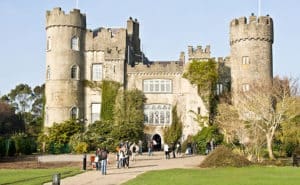The Tradition of Tree Shaping: Exploring Global Living Architecture Techniques
![The Tradition of Tree Shaping Exploring Global Living Architecture Techniques]](https://www.connollycove.com/wp-content/uploads/2024/03/The-Tradition-of-Tree-Shaping-Exploring-Global-Living-Architecture-Techniques.jpeg)
Updated On: March 21, 2024 by Aya Radwan
The tradition of tree shaping stands as a testament to the intersection of art, science, and nature, offering remarkable living structures that are as functional as they are beautiful. At the heart of this practice lies the ancient craft of cultivating and training living trees into designated shapes or patterns. This technique, which has evolved over centuries, integrates the growth of trees with architectural designs to create structures like bridges, playgrounds, furniture, and even homes. From the aerial roots of banyan trees crafted into living bridges in India to the verdant facades of modern Baubotanik structures in Germany, tree shaping exemplifies a sustainable approach to living architecture that continues to capture the imagination worldwide.
Tree shaping harnesses the natural processes of inosculation and grafting, where branches or roots of trees naturally intertwine and fuse. Drawing on this phenomenon, artisans and architects have developed a synergy between the biological growth of trees and the planned design of functional spaces.
Culturally and ecologically significant, these practices reduce the need for processed building materials and contribute to the local ecosystem by providing oxygen and combatting soil erosion. While innovations in design techniques promise to propel tree shaping into the future of architecture, the core principles of the craft remain rooted in an appreciation for nature’s capacity and the role that humans can play in guiding it.
Historical Roots of the Tradition of Tree Shaping

Tree shaping is a testament to the human ability to merge creativity with nature, turning living trees into functional and artistic structures. Across different cultures and centuries, this form of living architecture has reflected a deep understanding and respect for the natural world.
Axel Erlandson and the Circus Trees
Axel Erlandson, often hailed as the father of modern arborsculpture, channelled his fascination with trees into creating more than 70 topiary wonders on his California farm, which he later called the “Tree Circus”. Born from a simple inspiration — the sight of natural grafting in a hedgerow — Erlandson’s work echoes centuries-old Chinese practices of bending and shaping trees into intricate forms.
Inspired by his observations, Erlandson meticulously bent, grafted, and shaped live trees, developing methods that would define the art of tree shaping. His legacy reveals the meticulous patience required to craft these arboreal sculptures, some taking decades to mature into their intended designs.
Ancient Living Root Bridges
In the lush green landscape of Meghalaya, a tradition of tree shaping merges functionality with cultural practices. The Khasi and Jaintia peoples have mastered the art of creating living root bridges by guiding the pliable roots of the Ficus elastica tree across rivers and ravines. These root bridges, spanning up to 50 metres and last centuries, stand as profound examples of cooperative living architecture. Unlike Erlandson’s singular artistic pursuit, these structures result from community effort and Indigenous knowledge passed down through generations. They represent a connection between land and people and a sustainable approach to architecture that honours the environment.
Foundational Techniques and Science
In tree shaping, applying time-honoured techniques such as grafting and careful pruning is crucial to guiding a tree’s growth into functional and artistic structures. We delve into the science that supports these methods, ensuring the tree remains healthy and achieves the desired form.
Grafting and Inosculation
Grafting is a method we employ to fuse different plant tissues so they may grow as one. This often involves joining a scion or a piece of a young plant to the stock of an established tree. When the tissues of two or more plants grow together, a natural process known as inosculation occurs, which is essential in the art of arborsculpture. By understanding and manipulating this biological response, we create complex living structures.
Training and Pruning Methods
To shape trees effectively, training and pruning must be done with precision. Training involves gently bending and weaving branches to direct growth. We typically use spacers or frames to maintain the desired form as the tree develops. Conversely, pruning is selective cutting to remove unwanted branches or leaves that allow us to control and encourage growth in a specific direction or pattern. This hands-on approach to shaping trees requires patience and understanding the plant’s growth habits and response to manipulation.
Cultural and Ecological Significance

The tradition of tree shaping is an exemplary intersection of cultural expression and ecological understanding. It is a testimony to our ability to shape the natural world while fostering an environment that contributes positively to the ecosystem.
Sustainable Practices
We harness and manipulate living trees into useful and artistic forms in tree shaping. These living structures not only provide shelter but do so with a minimal environmental footprint. Sustainable techniques in arborsculpture ensure that as the trees grow, they absorb carbon dioxide, transform it into carbon in the form of biomass, and release life-sustaining oxygen back into the atmosphere.
Ecological Contributions
Through strategic tree shaping, we contribute to an ecosystem that supports an array of wildlife, offering food and habitat. Moreover, these arboreal constructs significantly combat soil erosion, preserving the delicate balance of local ecologies. This living architecture becomes an integral component of the natural ecology, mitigating the effects of climate change while enhancing the aesthetic and cultural landscape.
Architectural Forms and Structures
Tree shaping is not only an art form but a functional approach that merges architecture with the natural growth of trees to create living structures. We explore this practice’s artistic and practical aspects through arborsculpture and living architecture methods.
Arborsculpture
Arborsculpture represents the intricate craft of moulding and intertwining living trees into deliberate designs. Through careful pruning, grafting, and directing the growth of tree branches, we can form structures that provide shade and shelter while functioning as artistic displays. These living sculptures are often seen in the form of arches and canopies, creating not only aesthetic but also practical architectural elements.
Living Architecture Methods
The broader scope of living architecture encompasses using living trees and other organic materials to harmonise buildings or spaces with nature. Techniques involve guiding the growth of tree roots and branches to form sturdy structures, such as bridges, which are traditionally found in many cultures and serve the dual purpose of connectivity and respect for the environment. This practice integrates living trees directly to provide natural shelter and buildings, reducing the impact on the landscape while maximising the utility and beauty of nature’s creations.
Notable Tree Shapers and Projects

Certain individuals and projects stand out in living architecture due to their innovative approaches and breathtaking results. We will explore the impactful work of Richard Reames in arborsculpture and Ferdinand Ludwig’s contributions through Baubotanik, showcasing their unique techniques and the remarkable living structures they’ve created.
Richard Reames and Arborsculpture
Richard Reames, an American author and practitioner of arborsculpture, has significantly advanced this art form. He utilises a variety of species, such as willow and bamboo, to mould and shape trees into functional and artistic structures. Reames pioneered the technique of grafting trees to form natural joints, resulting in ecological and durable creations.
Marcel Kalberer, a German landscaper, also plays a pivotal role in this domain. His work with willow branches is a testament to the potential of natural materials in creating sustainable living art. Additionally, the Pooktre method, introduced by Peter Cook and Becky Northey, involves guiding tree growth into intricate shapes over time, leading to some of the most fascinating live sculptures.
Ferdinand Ludwig and Baubotanik
Ferdinand Ludwig’s approach, Baubotanik, or “Living Plant Constructions,” combines traditional architectural methods with living plants to erect living, breathing buildings. His pioneering work in this field has given rise to aesthetically pleasing structures and living entities that contribute positively to the environment. Ludwig often employs ficus trees for their robust qualities, integrating them into his architectural designs.
The interdependence between organic growth and architectural framework is central to Ludwig’s practice, resulting in structures that evolve, strengthen and adapt to their surroundings. His projects serve as a blueprint for how we might envision our urban landscapes more eco-consciously.
Tree Shaping Around the World
Tree shaping is an ancient practice that intertwines nature’s beauty with human ingenuity across the globe.
Asia
In the lush landscapes of Northeastern India, notably in Cherrapunji, a remarkable fusion of natural wonder and practical necessity exists. The local Khasi people have mastered an extraordinary skill – they guide the growth of the rubber tree roots to form living root bridges. These structures are a testament to the art of tree shaping, are critical for daily commutes, and have been seamlessly incorporated into the region’s way of life.
Europe
Europe offers a modern twist to traditional arboreal manipulation through a concept called Baubotanik, or “Living Plant Constructions”. Here, aesthetics and functionality converge, resulting in architecturally compelling structures from living trees. This form of urban greening, often seen in Germany, fuses botany with architecture to create eco-friendly installations, from playful park pavilions to imposing living towers.
Practical Applications of Tree Shaping
Tree shaping is an art form and has practical applications in creating functional structures and objects. We see these living designs as a seamless blend of nature and utility, offering solutions that are as practical as they are aesthetically pleasing.
Living Furniture
Tree shaping allows us to craft living furniture, turning growing trees into functional pieces such as chairs, tables, and benches. Through careful manipulation and guidance, trees are shaped over time into sturdy and unique items that continue to live and grow.
Examples of Living Furniture:
- Chairs: Grown from single or multiple trees, interwoven to provide back support.
- Tables: Horizontal platforms are created by training the horizontal growth of branches.
These living sculptures offer an eco-friendly alternative to traditional furniture manufacturing, reducing the need for processing and transportation.
Natural Shelter and Shade
Arborsculpture extends to larger structures, where techniques are applied to create natural shelters and shade. This form of ‘arbortecture’ is seen in the crafting of green cathedrals, tree houses, and shaded walkways.
Applications for Shelter and Shade:
- Green Cathedrals: Large, open spaces enclosed by living tree walls and ceilings, often used for gatherings.
- Tree Houses: Entire living quarters can be built within or around a framework of living trees supporting the structure.
This method offers an organic approach to architecture, integrating the built environment with the natural world for functional use.
Design Techniques and Innovation

Practitioners have developed intricate techniques to mould and guide plant growth in tree shaping into practical and artistic forms. Each method requires detailed knowledge and a hands-on approach, merging creativity with botanical insights.
Bonsai and Topiary
Bonsai, the Japanese art of growing miniature trees, involves careful pruning and wiring to shape the plant while maintaining its health and balance. Mastery of this technique turns trees into living sculptures that represent harmony and patience. The aesthetics of bonsai derive from selecting appropriate plant species and understanding their growth patterns to create a desired miniature landscape.
On the other hand, topiary has been adopted in many cultures to shape plants into geometric forms or fanciful figures. It’s a craft of precision where shears and clippers become the artist’s tools. Both bonsai and topiary engage in a dialogue with nature, as artists respect the innate properties of the plant while guiding it into an aesthetically pleasing form.
Modern Tree Shaping and Biodesign
Modern tree shaping extends these traditional techniques through innovative approaches like biodesign, where biology and architecture converge. Plant constructions integrate living and non-living components to develop functional structures that grow and evolve, such as bridges and shelters.
One pioneering project in this arena is ‘The Patient Gardener,’ which envisions a future where we collaborate with trees through pleaching. This method weaves and grafts branches together to form strong, living structures. As the plants grow, the gardener’s role blends with the natural process, resulting in architecture that is both sustainable and dynamic. This merge of design and horticulture exemplifies how we’re pushing the boundaries of conventional construction and garden design, creating a new vernacular of living architecture that could redefine our built environment.
The Role of Tree Shaping in the Future
As urban landscapes continue to evolve, tree shaping stands poised to become a significant element in the design and function of cities, contributing positively to environmental and climate considerations. This artistic yet practical approach to cultivating living structures is gaining momentum as a strategy to meet the challenges of both today and a balanced tomorrow.
Urban Design Integration
In pursuing greener urban environments, tree shaping offers a compelling trajectory for incorporating natural elements within cityscapes. Incorporating living trees into building design—a practice known as arborsculpture—can mitigate urban heat islands due to the high concentration of surfaces that absorb and retain heat.
The strategic placement of shaped trees could provide shade, reduce the reliance on air conditioning, and lower greenhouse gas emissions. As city planners aim to counteract pollution and foster sustainability, the integration of tree shaping within parks, green belts, and building facades is not just aesthetic but functional, supporting biodiversity and enhancing the quality of life for city dwellers.
Environmental and Climate Considerations
Our collective response to climate change necessitates inventive and nature-based solutions, of which tree shaping could play a pivotal role. Shaped trees, as living components of our future infrastructure, can contribute to carbon sequestration. Their ability to absorb carbon dioxide, a primary greenhouse gas, affirms their utility in climate change mitigation efforts.
Beyond carbon capture, these living sculptures also improve air quality and can serve as natural water filtration systems, helping to reduce the impact of heavy metals and pollutants. Their role in the future of urban design may also extend to creating sustainable and functional green spaces, including living bridges and natural shelters that blend seamlessly into the ecosystem, providing relief in an increasingly urbanised world.
Preservation and Education
In arborsculpture, we must not only conserve the living sculptures that constitute our heritage but also impart the knowledge needed to sustain this art form. Through active conservation and education efforts, we ensure this unique blend of art and science flourishes.
Conservation of Tree-Shaped Heritage
We recognise the importance of maintaining tree-shaped heritage, as these living structures represent centuries of cultural tradition. Gardeners and botanists collaborate closely in botany-building initiatives that honour traditional techniques while incorporating modern conservation practices. This fusion ensures that our arboreal architectures remain as static artefacts of the past and as growing, thriving testimonies of our heritage.
- Training Trees: Requires skilled hands and years of dedication.
- Conservation Methods: Include careful pruning, guided growth, and protection from environmental stressors.
Spreading Knowledge through Workshops
Education is a cornerstone in the preservation of tree shaping. We conduct hands-on training workshops, allowing participants to learn from experienced gardeners. These workshops aim to:
- Empower new generations with the skills necessary for tree shaping.
- Foster appreciation for this unique form of living architecture.
Workshops detail:
- Content: The history of arborsculpture, basic techniques, and conservation methods.
- Audience: Ranging from hobbyists to professional gardeners.
By intertwining conservation and education, we play our part in ensuring that the tradition of tree shaping continues to be a testament to our symbiotic relationship with nature.
Frequently Asked Questions

Tree shaping, or arborsculpture, involves cultivating and manipulating living trees to form structures and designs. This art form combines horticulture and design. In this section, we will address some common queries about tree shaping.
How are living tree structures cultivated and maintained?
To cultivate living tree structures, we select and plant specific tree species and then guide their growth through careful pruning, grafting, and training around frames. The maintenance involves regular watering, fertilising, and monitoring for pests or diseases to ensure healthy growth and the desired shape over time.
Which species of trees are most suitable for arboreal shaping?
We typically find species with flexible branches and rapid growth, such as willows, poplars, and some types of figs, most suitable for arboreal shaping. These species can be easily manipulated and tend to heal quickly from the shaping process.
What techniques are employed in the shaping of trees and shrubs?
The techniques include grafting to join different plants, bending branches over frames, and pruning to encourage growth in specific directions. More advanced methods involve twisting, braiding, or weaving branches to create intricate patterns or structures.
Can you describe the historical development of arboreal architecture?
Arboreal architecture’s historical development dates back to ancient practices, with examples like the living root bridges in Northeast India. Over centuries, the craft has evolved from practical applications, such as creating living fences, to an art form practised worldwide.
What are the considerations for integrating live trees into building designs?
When integrating live trees into building designs, we consider tree species, growth rates, and root systems to ensure structural integrity and longevity. Environmental factors, such as climate and soil conditions, play a crucial role in the trees’ health and the design’s viability.
How does arbor-tecture differ from conventional sculpting of trees?
Arbor-tecture differs from the conventional sculpting of trees. It is a long-term process focused on guiding and incorporating living trees into structures or landscapes rather than simply trimming or shaping them for aesthetic purposes. It blends functionality with artistic expression.






